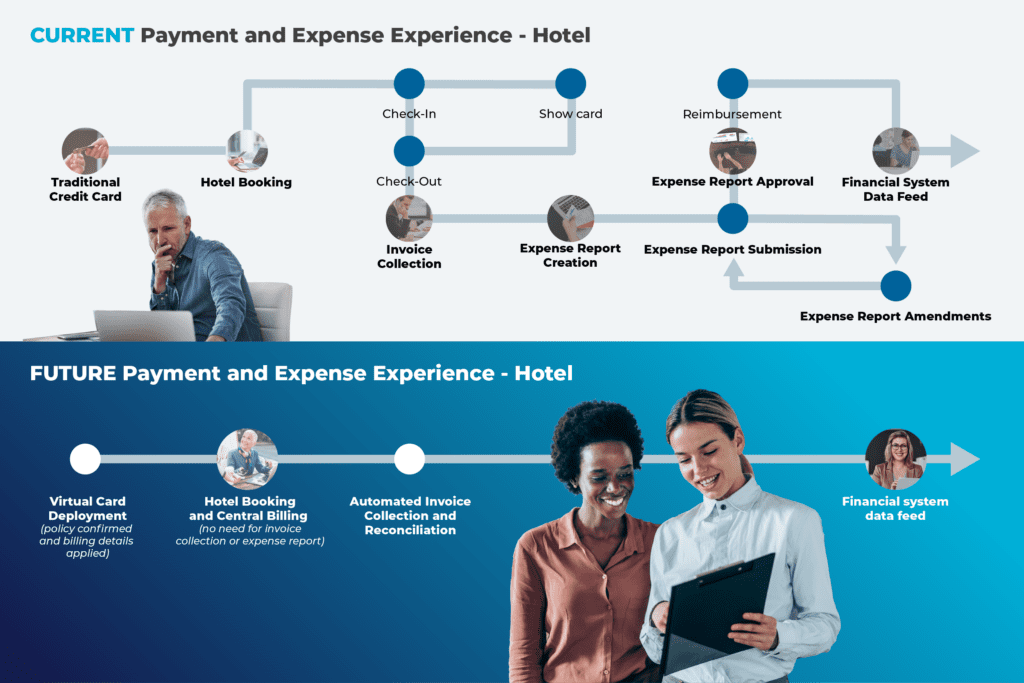
Digitization of the buyer encounter is influencing just about every corner of corporate vacation. When it will come to payments and expense management, that usually means giving a lot more seamless answers for employees so that they don’t have to figure out how to pay for small business vacation, manually accumulate and enter receipts, or spend hrs submitting cost reviews.
It is not just about the person practical experience these answers provide organizational efficiencies as very well. Providers that are not all set to make the shift to digital cards and automated cost administration are now out of sync — with monetary technological innovation breakthroughs, with vacation supplier payment methods, with inner departments, and finally with what their workforce want.
This short article explores key behavioral alterations among the business travelers and how providers can regulate their company vacation, payment, and cost procedures and procedures in techniques that improve performance, decrease expenses, and enhance employee fulfillment.
Resolving Agony Details in Payments and Reconciliation
Business enterprise travelers globally are progressively demanding that their employers provide technological innovation they use in day-to-day everyday living. For case in point, contactless payments turned a great deal more popular throughout the Covid-19 pandemic, and contactless transaction values are anticipated to double in the next 5 decades. Corporate card people who’ve adopted this technological know-how in their individual lives now anticipate the identical simplicity and ease of use when they travel for work.
The shifting tech landscape has led corporate vacation and finance managers to an inflection stage as well. Coordinating business enterprise journey is intricate, and the payment and cost administration method by itself is high priced and painful to take care of.
“Expense management is a reactive course of action,” reported Ajay Singh, vice president, digital payment and expenditure merchandise development at BCD Journey. “Plus, there are all these different traveler profiles — VIPs, highway warriors, infrequent tourists, even non-staff members — who all have distinct demands, and that leads to a lot of pain for journey supervisors.”
Traditionally, the root of the challenge for cost administration has been the deficiency of integration between diverse methods and procedures. (See the graphic underneath for a snapshot of what a usual payment and expenditure practical experience for a resort scheduling appears to be like like nowadays.) Digital playing cards are one illustration of how electronic remedies integrate payments, coverage, and cost management to make the process a lot more proactive. By bringing these elements with each other, they existing a big possibility to renovate company journey, payment, and price, Singh reported.

A single crucial advantage of digital cards — which can be deployed during a vacation reserving or ahead of a begin of the vacation as a one of a kind card or payment token by using a user’s cellular cellular phone — is that they’re versatile. They can be possibly one-time or various-use, and they can have a set limit. In the future, virtual cards will be able to be provisioned into cellular payment devices these as Apple Pay out, Samsung, and Google Pay out for a unique vacation or individual shell out.
A different crucial benefit is that administrators can embed rules about how these digital cards can be used — and update them immediately in response to precise scenarios as a substitute of possessing to review and reissue an complete corporate travel coverage.
In addition, in its place of issuing a plastic card that lasts 3 or five or 7 decades and can be swiped when and anywhere, a virtual card is substantially more controlled. Considering that digital playing cards have different developed-in coverage, controls, and expend limitations, they are more secure as opposed to a common card.
Since paying data can all be tracked in serious time, there’s no will need for a traveler to file an cost report. As travelers use their cellular telephones to pay contactless for coffee, foods, taxi rides, or inns, they can get the charges in true time and add the receipts, if demanded, on the go. By the time they are carried out with their trip, all the expenditures, if compliant, are ready to be pushed into finance and cost methods. Businesses can also input the price center and billing specifics forward of time so that fees really don’t have to be allocated after the simple fact.
By automating and integrating payments, policy, and expense reporting, “you’ve turned the entire process upside down,” said Singh. “You’ve taken a reactive method with a whole lot of guide measures and produced it a lot more proactive, a lot more true time, far more dynamic, and far more automatic in contrast to what it is currently these days.”
The Promise of a New Payment and Cost Approach
Transformation is never ever quick. Very first of all, while there are a lot of early adopters out there, it will acquire some time for a greater part of today’s company travelers to change their technological know-how patterns, even if they are fired up by the probable advantages.
There are also sensible issues for companies on the specialized aspect. As just one instance, some automatic price methods operate by consolidating all vacation charges into a one payment technique with a one payment issuer. That is effective very well in some cases, but it is not practical for packages with a number of suppliers and several payment partners.
In the meantime, hundreds of billions of expense bucks have gone into fiscal technologies, or fintech, in the past a number of decades. That features retailers that have adopted contactless payment methods, as effectively as major banking institutions and card issuers (i.e. Visa, MasterCard, AMEX) upgrading their current platforms to help new sorts of payment constructions on the backend. In addition, more and additional organizations are exploring remedies and products and services wherever vacationers do not have to use personal playing cards for business enterprise outings.
With these trends converging, there’s an urgency for firms to keep up, addressing automation requirements so that their have methods can use the tools and info they are having from suppliers. Ultimately, corporations have to consider a tough search at what suits their technological capabilities and their traveling employees best, and then work together with their vacation administration business and know-how companions to acquire the proper mixture of solutions to start off their payment and price journey.
“The digitization of company journey is heading to go as a result of a phased transformation that will shape out above the following few years, necessitating instruction and early adopters to appear on board,” stated Singh. “But there’s a tremendous worth proposition that these new methods are bringing to the field — merchants, their purchasers, company suppliers like us, and the traveler.”
The draw back in the course of this transformation interval is contending with the position quo, which is characterized by fragmented processes and programs. There are silos in just companies by themselves, silos concerning journey suppliers and distribution methods, and silos between fiscal establishments, which all go decades again. As a single transaction moves via from close to close, each individual program is diverse and has distinctive details and information.
The antidote to this fragmentation is data integration. By seamlessly and proactively connecting vacation to payments to automated price reporting and reconciliation, providers will be in a position to obtain additional dependable, additional accurate data, which can let them to consolidate this information into a single view of their program.
Singh observed that knowledge integration normally has been a agonizing, guide approach sitting down with distinctive teams. By using artificial intelligence/equipment finding out abilities to carry a ton of data sets with each other, providers are in a position to match, reconcile, and simplify those processes.
“The option is tying anything together at the time of reserving and at the time of the vacation,” said Singh. “So in its place of a backward-on the lookout cost administration approach, you increase or take out price management as we know it today. It is still taking place, but all in the qualifications. The payment gets to be your expense administration, and the plan is embedded with each other. It is reactive to proactive, guide to automated, sophisticated to simple.”
For more information and facts about BCD Travel’s payment and price resolution, visit https://www.bcdtravel.com/journey-management/bcd-spend/.
This material was developed collaboratively by BCD Journey and Skift’s branded content studio, SkiftX.







